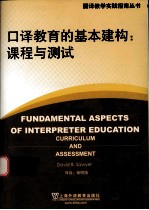图书介绍
口译教育的基本建构 课程与测试PDF|Epub|txt|kindle电子书版本网盘下载

- 索亚著 著
- 出版社: 上海:上海外语教育出版社
- ISBN:9787544620796
- 出版时间:2011
- 标注页数:310页
- 文件大小:18MB
- 文件页数:336页
- 主题词:翻译-教学法-高等学校
PDF下载
下载说明
口译教育的基本建构 课程与测试PDF格式电子书版下载
下载的文件为RAR压缩包。需要使用解压软件进行解压得到PDF格式图书。建议使用BT下载工具Free Download Manager进行下载,简称FDM(免费,没有广告,支持多平台)。本站资源全部打包为BT种子。所以需要使用专业的BT下载软件进行下载。如BitComet qBittorrent uTorrent等BT下载工具。迅雷目前由于本站不是热门资源。不推荐使用!后期资源热门了。安装了迅雷也可以迅雷进行下载!
(文件页数 要大于 标注页数,上中下等多册电子书除外)
注意:本站所有压缩包均有解压码: 点击下载压缩包解压工具
图书目录
CHAPTER 1 Introduction1
1.Challenges facing interpreter education3
2.The integrative role of assessment5
3.The objectives of this book9
4.Methodological considerations10
5.Overview of contents15
CHAPTER 2 Interpreter education literature19
1.Curriculum26
2.Expertise29
3.Assessment31
4.Language transfer competence35
5.Conclusions37
CHAPTER 3 Fundamental aspects of curriculum39
1.Definitions41
1.1 The official curriculum41
1.2 The hidden curriculum42
2.Foundations43
2.1 Philosophy44
2.2 History46
2.3 Psychology48
2.4 Sociology49
3.Guidelines50
3.1 Educational philosophy53
3.2 The aims of instruction55
3.3 Program goals55
3.4 Teaching objectives58
3.5 Curricular implications59
4.Approaches60
4.1 Scientific-curriculum as process60
4.1.1 The computational view of the mind61
4.1.2 Skills and abilities in Instructional Systems Design63
4.1.3 The cognitive psychology of expertise65
4.1.4 Levels of expertise in interpreting70
4.1.5 Implications for curriculum sequencing73
4.2 Humanistic-curriculum as interaction74
4.2.1 A community of professional practice75
4.2.2 Cognitive apprenticeship76
4.2.3 Reflective practice79
4.2.4 Situated cognition and learning81
4.2.5 Implications for the learning environment84
5.Models85
5.1 Curriculum models according to Arjona85
5.2 Curriculum components88
6.Steps toward effective curriculum design90
7.Conclusions91
CHAPTER 4 Foundations of interpreter performance assessment93
1.Concepts95
1.1 Validity95
1.2 Reliability101
1.3 Subjective and objective testing103
1.4 Measurement scales105
1.5 Formative,summnative,and ipsative assessment106
1.6 Test specifications107
2.Integrating curriculum and assessment:Developmental milestones108
2.1 Entry-level assessment109
2.2 Intermediate assessment112
2.3 Final assessment113
3.Evidential bases of construct validity114
3.1 Scientific approaches:Criteria114
3.2 Humanistic approaches:Domain116
3.3 Guidelines:Standards118
4.Standardization in testing119
5.Authenticity121
6.Alternative assessment:Portfolios125
7.Steps toward valid and reliable assessment128
8.Conclusions129
CHAPTER 5 Introduction to the case study131
1.Research questions131
2.General comments on method and scope131
3.Content analysis of GSTI curriculum documents133
3.1 Aims,goals,objectives133
3.2 Process:Knowledge and skill sequencing135
3.3 Interaction:Educational environment142
3.4 Assessment and the curriculum143
CHAPTER 6 Case study Part Ⅰ:Translation and interpretation competence145
1.Introduction145
2.Method147
2.1 Quantitative description of curriculum in the GSTI147
2.1.1 First-year curriculum for MATI and MACI147
2.1.2 Second-year curriculum for MATI and MACI149
2.1.3 Second-year translation coursework for MATI151
2.1.4 Second-year interpretation coursework for MATI and MACI153
2.1.5 Advanced-entry course of study156
2.1.6 The GSTI hidden curriculum156
2.2 Subjects157
2.3 Materials-Professional Examinations in the GSTI159
2.3.1 Text selection161
2.3.2 Text delivery161
2.3.3 Examinations in consecutive interpretation162
2.3.4 Examinations in simultaneous interpretation162
2.3.5 Jury composition162
2.3.6 Scoring criteria163
2.3.7 Scoring procedure163
2.4 Procedures-data collection163
2.5 Analysis168
3.Results169
4.Discussion171
CHARTER 7 Case study Part Ⅱ:Survey of exam jury members177
1.Introduction177
2.Method178
2.1 Subjects178
2.2 Materials-survey content178
2.2.1 Background of jury members179
2.2.2 Exam procedures179
2.2.3 Purpose of the exams180
2.2.4 Assessment criteria180
2.2.5 Jury conduct and role of external examiners182
2.2.6 Additional comments182
2.3 Procedures182
2.3.1 Questionnaire design182
2.3.2 Questionnaire administration183
2.3.3 Return rate183
2.4 Analysis183
2.4.1 Data preparation183
2.4.2 Data analysis184
3.Results184
4.Discussion187
CHAPTER 8 Case study Part Ⅲ:Analysis of exam texts191
1.Introduction191
1.1 Analytical tools191
1.2 Exam texts and the curriculum192
1.3 Exam texts as documents193
2.Method194
2.1 The corpus195
2.2 Procedures196
2.3 Analysis197
2.3.1 English source language materials197
2.3.2 French source language materials200
2.3.3 German source language materials201
3.Results203
3.1 Exam texts for consecutive interpretation203
3.2 Exam texts for simultaneous interpretation204
4.Discussion204
4.1 Length204
4.2 Propositional content205
4.3 Illocutionary force206
4.4 Conclusions207
CHAPTER 9 Implications of the case study209
1.Part Ⅰ:Translation and interpretation in the GSTI curriculum209
2.Part Ⅱ:Standardization,authenticity,and professional judgement210
3.Part Ⅲ: Exam materials and test method facets212
4.Addressing the research questions213
CHAPTER 10 Curriculum enhancement:An integrated Y-track model215
1.Aims and goals of the curriculum220
2.Integrated assessment224
3.Curriculum as process225
4.Curriculum as interaction227
5.Flexibility and streamlining228
Outlook:On the political and ethical consequences of test validation231
Notes237
APPENDICES241
Appendix A241
Appendix B244
Appendix C252
References265
Name index303
Subject index307